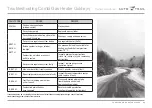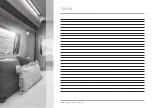
49
together we’re going places
Care Of Windows cont.
It is a popular misconception that acrylic
Motorhome windows are vacuum sealed,
this is not so. The windows in a Motorhome
can, as with domestic glazing, be susceptible
to temporary condensation if the temperature
difference between inside and outside changes
quickly and / or dramatically i.e. if a cold Motorhome
is heated quickly using the
heater or by the sun.
These drastic changes of temperature and the
moisture in the air both contribute towards the
temporary condensation that will normally disappear
as quickly as it appears.
This whole phenomenon is purely related
to ambient temperature changes of the
Motorhome compared to the window cavities.
Notes on internal condensation
Condensation occurs when warm moist air meets
a cold surface. The risk of condensation therefore
depends upon how moist the air is and how cold the
internal surfaces of the vehicle are.
Condensation is normally more noticeable during the
winter months as the Motorhome is cold and because
skylights, windows and doors are opened less meaning
that the moist internal air cannot escape.
How to try to minimise the likelihood of
condensation occurring
To try to minimise the risk of condensation occurring it
is important to try to maintain some level of ventilation.
Your vehicle complies with EN721: 1988 which states
the minimum requirements for high and low level
ventilation, it is very important that these are not
blocked or reduced in any way.
Try to provide reasonable heating.
If possible use the electric element of the space
heater when washing, cooking or drying damp clothes,
particularly if the windows show signs of misting up.
Try to make sure all areas are at least partially heated,
condensation most often occurs in unheated areas.
To prevent condensation the heat has to keep the room
surfaces reasonably warm.
It can take a long time for a cold Motorhome to warm
up so it is better to have a small amount of heat for a
long period rather than a lot of heat for a short time.
A Motorhome that have been left unoccupied of long
periods of time can become very cold. Whenever
possible it is best to put the heating on at a low level
before setting off on a journey in the winter to pre heat
the vehicle.
Even in a well insulated Motorhome with correct
ventilation it is likely during cold weather if the
temperature is less than 10
o
C that condensation will
occur. Ideally the temperature should be kept at about
20
o
C although this is not always possible.
Motorhome Interior Side Walls, Roof Lining
and Furniture
A simple wash with a damp cloth and a mild detergent is
all that is necessary.
Soft Furnishings
Carpets should be vacuumed occasionally to remove
grit and sand. This helps maintain good appearance
and ensure long life.
The upholstery can be cleaned with a mild reputable
upholstery cleaner.
It is recommended that curtains be dry cleaned.
Cupboard Catches
It is advisable to lightly oil cupboard catches,
sliding bolts and hinges from time to time.
Vanity Unit / Shower Cubicle
Your vehicle is fitted with a plastic vanity bowl. Do not
pour very hot water into it as it is made from a moulded
polymer that may deform, always put cold water in first.
Care Of Plastic Components
The cleaning of any plastic components in the vehicle,
e.g shower tray, should only be undertaken with mild
soapy water. General household cleaning products
should not be used as they may cause the plastic to
go brittle and crack.
Auto-Trail will not be held responsible for any
replacement if it is suspected that this was the case.
Plated Fittings
These should never be cleaned using abrasive cleaners.
Clean with a damp cloth and polish with a dry cloth only.
Natural Wood Worktop Edges
Should your vehicle worktop edges show signs of the
lacquer breaking down, they should be re-sealed using a
proprietary yacht varnish, (or equivalent).
General Care
Owners Handbook :




































